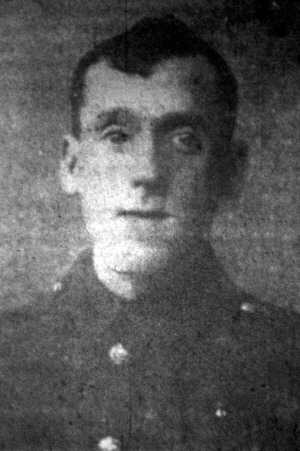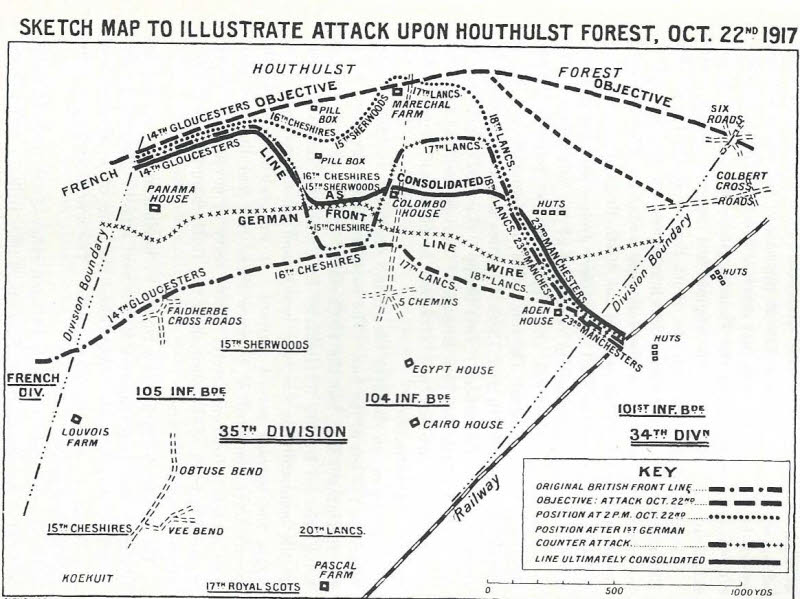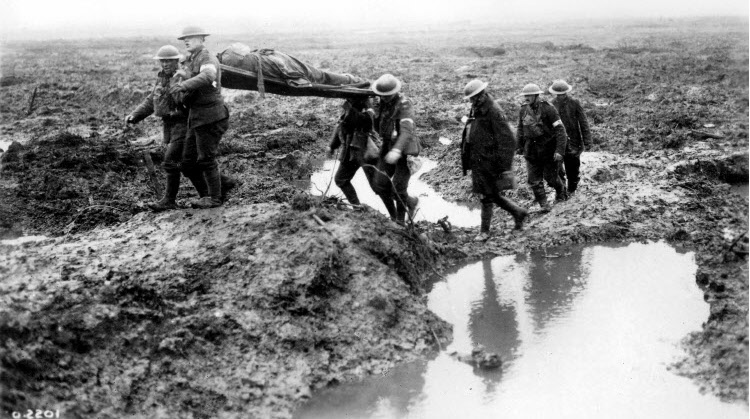
David Butterfield was born in Ossett in 1884, the son of David Butterfield and Ann Wood who were married at South Ossett Church on the 19th May 1863. They were to have eleven children, all surviving by 1891. In that year, Ann is aged 47 and a widow living at Park Square, Ossett with nine of her children: five boys and four girls, aged between 5 and 23 years with David being the second youngest child. David’s father, also named David, died in 1890 at the early age of 47.
By 1901, the Butterfield family have moved to live at Manor Road, Ossett, close to the junction with Station Road. Ann Butterfield is living with five of her children, including David, now aged 17 and working as a painter’s apprentice. All of the other children are working in the rag or clothing trade.
In 1911, David has moved away from Ossett, and he is working as a man-servant at the 16-roomed Low Hall, Kirkby Overblow, Pannal, near Harrogate. He is one of four servants, including a cook, a housemaid and a between-maid, in the home of Sarah Elizabeth Ingham, a 61 year-old widow of independent means.
The 15th (Nottingham) Battalion, Sherwood Foresters (Nottinghamshire and Derbyshire Regiment) was raised at Nottingham in February 1915, by the Mayor and a Committee, as a Bantam Battalion, from troops who were under the normal regulation minimum height of 5 feet 3 inches.
After initial training close to home, they joined 105th Brigade in 35th Division at Masham, North Yorkshire in June 1915. The Division moved to Salisbury Plain for final training in August. They were ordered to Egypt in late 1915, but the order was soon cancelled and they proceeded to France on the 1st of February 1916, and the division concentrated east of St Omer. They were in action during the Battles of the Somme at Bazentin Ridge, Arrow Head Copse, Maltz Horn Farm and Falfemont Farm.
The division received new drafts of men to replace losses suffered on the Somme, but the Commanding Officer soon discovered that these new recruits were not of the same physical standard as the original Bantams, being men of small stature from the towns, rather than the miners and farm workers who had joined up in 1915. A medical inspection was carried out and 1439 men were transferred to the Labour Corps. Their places being taken by men transferred from the disbanded yeomanry regiments, who underwent a quick training course in infantry methods at a Divisional depot set up specifically for that purpose. In 1917 they were in action during The pursuit to the Hindenburg Line, at Houthulst Forest and the Second Battle of Passchendaele.
It is likely that Private David Butterfield was a batman for one of the Sherwood Foresters officers and therefore at the front during battle. He was killed in action on the 22nd of October 1917 in bitter fighting leading up to the Second Battle of Passchendaele. During this month, the 35th Division left the Somme area for the first time since they arrived in France. The BEF had launched a very large offensive in Flanders on 31st July 1917; a strategic initiative to break through the German lines in front of Ypres, and to achieve re-capture of the Belgian ports and coast. This offensive soon ran into difficulties. The worst summer weather in Flanders for decades turned much of the Ypres area to deep mud, and the infantry ran into an unsuspected deep array of enemy concrete pillboxes holding machine gun posts. This unfortunate offensive, which was never to break through the enemy, has long been known as the Battle of Passchendaele, after a village at the extreme extent of the British advance, which was captured in November. In October, it was the turn of 35th Division to move into this appalling affair.
“The Battle of Houthulst Forest 22nd October 1917:- At 2 a.m. on the 22nd October, the battalions formed up on tapes in advance of the original line. This was done to escape the hostile shelling which covered the front line at dawn.
The attack was launched at 5.35 a.m. under an artillery creeping barrage at the rate of 100 yards per eight minutes. The 23rd Manchester had been unable to gain touch with the 101st Brigade, 34th Division, on the right, and this unfortunate accident had a serious influence on the succeeding operations. The battalion, nevertheless pushed on, and from this point the resistance became more stubborn and the battalion was exposed to heavy machine-gun fire from the flanks from sets of huts which appear to have been overlooked. All the officers and a large proportion of the NCOs were killed or wounded [and] other ranks 20 killed, 115 wounded, 55 missing.
On the night of the 21st/22nd October, the companies moved forward into the assembly positions. The 15/Sherwood Foresters were in support of the line Strong Point, north of Louvois farm-Obtuse Bend. The troops started close under the barrage but owing to the state of the ground found some difficulty keeping up with it. A pill-box in front of the right also gave some trouble but by 7.45 a.m. the whole battalion was on the final objective and support lines were being consolidated. Touch had been lost with the right battalion, but Captain Russell, who was now in charge of the front line managed to obtain contact and then called for assistance from Captain Harvey, 15/Sherwood Foresters who led forward a platoon of his company to close the gap From 2 p.m. to 4.30 p.m.
The front remained comparatively quiet, but, at the latter hour, the enemy launched a determined counter attack against the 16/Cheshires, and broke through the line. The remnants of the three companies of the 16/Cheshires and one company of the 15/Sherwood Foresters, which had come up in support, finding themselves isolated and partly surrounded, fell back from the forest for about 100 yards and there offered further resistance. They were eventually compelled to withdraw to the original line. The only battalion left on the original objective was the 14/Gloucester.
The counter attack here was caught by the artillery barrage and was not pushed home, so that the troops had no difficulty in holding the ground gained. The right flank, however, was slightly refused in order to link up with the 16/ Cheshires and a platoon of the 15/Sherwood Foresters was placed in the gap. Whilst this was happening the enemy was reported to be massing in the wood. Artillery fire was called for and the area bombarded. Nevertheless the enemy advanced to the attack, but was repulsed with heavy loss. Communication became extremely difficult. Heavy hostile barrages were put down behind our lines and the neighbourhood of the various battalion headquarters, was systematically shelled. Units, also, had become mixed up, and the men of the assaulting battalions were at length showing signs of exhaustion. The weather grew worse, and movement over the country became increasingly difficult. Fortunately, successful attempts to carry forward tea and rum to a great extent alleviated the sufferings of the troops.
No further action took place on the 22nd October. Both the assaulting battalions of the 105th Brigade were relieved and the line was held with the 15/Cheshire, the 15/Sherwood Foresters being mostly in support.” 1
Somewhere in the chaos of this action, Private David Butterfield, 305915, 15th Battalion, Sherwood Foresters, lost his life.

The “Ossett Observer” 2 had this obituary for David Butterfield:
“South Ossett Soldier Killed in Action – The supreme sacrifice has been made in the war by another Ossett soldier – Private David Butterfield (33) of the Sherwood Foresters, whose widowed mother resides at Horbury-road, South Ossett. As a boy, Private Butterfield attended Christ Church day school and was a member of the choir, but for a good number of years prior to the war, was in service away from Ossett. He enlisted in the army about three years ago and most of the time was an officer’s servant. Early this year he went to the front and was afterwards wounded and seriously ill, and invalided home. As recently as August last he returned to the front.
His mother has received this week a letter from the officer of the platoon to which the deceased was attached, stating that Private Butterfield had been killed in action. The writer stated that the company commander and himself were in a position to see and appreciate his excellent work before he was ‘knocked out’. Both sent their sincere sympathy and said that it might be some compensation to know that he was killed instantly and could not possibly have suffered any pain. An army chaplain has also written, confirming the sad news, stating that he lost his life in a big attack on the Flanders front.”

Above: Appalling conditions at Passchendaele in October 1917.
Private David Butterfield is remembered on Panels 99 to 102 and 162 to 162A on the Tyne Cot Memorial 2, West-Vlaanderen, Belgium. The Tyne Cot Memorial to the Missing forms the north-eastern boundary of Tyne Cot Cemetery, which is located 9 kilometres north east of Ieper town centre, on the Tynecotstraat, a road leading from the Zonnebeekseweg (N332).
The Tyne Cot Memorial is one of four memorials to the missing in Belgian Flanders which cover the area known as the Ypres Salient. Broadly speaking, the Salient stretched from Langemarck in the north to the northern edge in Ploegsteert Wood in the south, but it varied in area and shape throughout the war. The Tyne Cot Memorial now bears the names of almost 35,000 officers and men whose graves are not known.
References:
1. “The History of the 35th Division in The Great War”, by Lieutenant–Colonel H.M.Davison C.M.G., D.S.O.,R.A. Published by The Naval & Military Press in 1926
2. “Ossett Observer”, 3rd November 1917